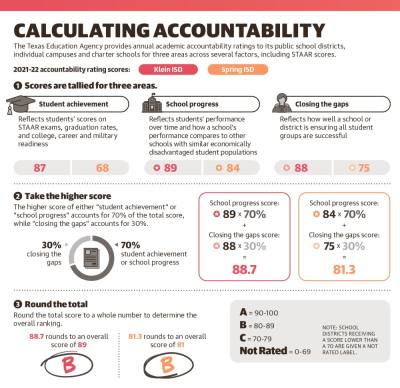Students across the state began standardized testing through a completely online format for the first time—with testing beginning April 18—after legislators called for a revamped test in 2019.
The State of Texas Assessments of Academic Readiness test students beginning in third grade and were administered online because of House Bill 3906, which was passed during the 86th legislative session in May 2019. The redesigned test also features more question varieties and changes to written essay prompts, and requires student knowledge of subjects outside of the one being tested, according to the Texas Education Agency.
“Feedback from educators informed the main components of the STAAR redesign, and both educators and students provided input to ensure STAAR better reflected the classroom experience,” a TEA spokesperson said in an May 5 email.
Klein ISD teacher Angela Stutes—who teaches fifth grade at Nitsch Elementary—said she has worked all school year to prepare her students for STAAR, which is more rigorous because of the new format.
“[The new STAAR test] is harder, because [the students] have to prove their answers now beyond just saying, ‘OK, this is the answer,’” Stutes said.
During an April 6 Spring ISD trustee meeting, LaTracy Harris, SISD’s assistant superintendent of academics said the district has been working since the 2022-23 school year began in August to acclimate students to the new STAAR test questions.
“We wanted to make sure that we could expose our students so they have an opportunity to practice and be prepared for the STAAR test,” Harris said.
Despite HB 3906’s updates to STAAR, the test will still contribute to the A-F scale accountability ratings the TEA assigns each campus and district. The TEA is typically required, under state law, to conduct interventions—requirements for districts to provide better staff and resources to lower performing campuses—with schools who receive “not rated” scores, or ratings lower than a C. Exceptions were made for the 2020-21 school year, when schools were not rated due to the coronavirus pandemic, but intervention resumed in the 2021-22 school year.
Multiple bills in the ongoing 88th Legislature seek to change the role STAAR plays in district accountability scores. Bob Popinski, senior director of policy for public education advocacy group Raise Your Hand Texas, said he believes STAAR should be de-emphasized as an accountability metric.
“We believe in good assessments, formative assessments that help inform instruction throughout the school year,” Popinski said. “The STAAR test, as it stands today, is not one of those types of tests. It’s a one-day test [taken] on one day, and it’s just a snapshot in time.”
The new test
STAAR exams measure student progress in reading, math, science, social studies and writing—a goal that hasn’t changed, according to the TEA.
“Assessments provide teachers and parents with helpful information to see how individual students are performing so they can better support those students moving forward,” a TEA spokesperson said.
The new online STAAR will allow school districts to receive student scores quicker and cut supply costs compared to the paper test, Harris said.
“[The new STAAR test] will also give us an opportunity to increase accommodation options for our students ... and then also ... allow our students to use higher-level thinking and to complete assessments in a variety of ways,” Harris said.
With testing wrapping up May 12, districts can expect to receive early raw scores as soon as May 22, according to the TEA website.
In addition to being online, the new STAAR test features a maximum of 75% multiple choice questions while the remaining portion consists of 14 question types. The new question types have students perform tasks such as selecting a point on a map or adding the missing portion of an equation, according to the TEA’s website.
For reading passage test questions, students may need to use knowledge from subjects outside of the one they are being tested for. Essays on language arts STAAR tests will now be based on a reading passage instead of an independent writing prompt, according to a TEA spokesperson. Reading and writing tests have also been combined into one test, which impacts grades four and seven.
Stute applauded KISD for helping teachers prepare for the new STAAR test, but she said she believes information from the TEA was lacking. A specific rubric for how the new essay portion of the reading and writing STAAR will be scored, for example, was never provided, she said.
Pushing for change
Under the TEA’s current accountability system, ratings are determined by student STAAR scores, graduation rates, and college, career and military readiness outcomes. For elementary and middle schools, STAAR scores are the sole consideration for campus accountability ratings, Popinski said.
Before the redesigned STAAR debuted in April, teachers and community members had low faith in STAAR, according to polls from the Charles Butt Foundation—a nonprofit research organization that that is a sister organization to Raise Your Hand Texas.
The 2022 Texas Teacher Poll—which was conducted via an online questionnaire April 4-May 16, 2022—found that 83% of teachers surveyed were not confident that STAAR properly measures how well a student is learning. Meanwhile, 98% of teachers and 83% of Texans thought STAAR tests should not be the sole measurement for a school district’s accountability rating.
“[STAAR being involved in accreditation] makes it a high-pressure, high-intensity test for all involved: students, teachers, school districts, communities,” Popinski said.
Multiple legislators in the ongoing 88th session—which ends May 29—hope to change the accountability model. HB 4402 would change the rating system so STAAR scores have less influence. The bill was approved by the House on May 9, in a 128-17 vote with two representatives abstaining, according to the Texas Legislature Online. The bill had not been voted on by the Senate as of press time.
Texas representatives have also filed other bills to further evolve the STAAR test and the role it plays in school district accountability. For example, HB 337 would alter certain end-of-course assessment and graduation requirements, and HB 680 would implement “growth-based” assessments that can be catered to students’ needs.
Similar bills include HB 535, which expands the indicators used to measure public school achievement, and HB 37, which would establish a commission tasked with developing recommendations to improve public school accountability systems.
House Bills 337, 680, 535 and 37 have not yet passed as of press time.
Wesley Gardner and Hannah Norton contributed to this report.








